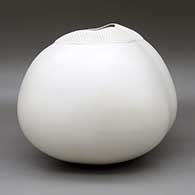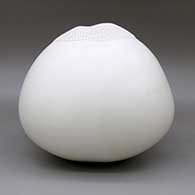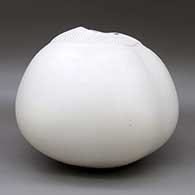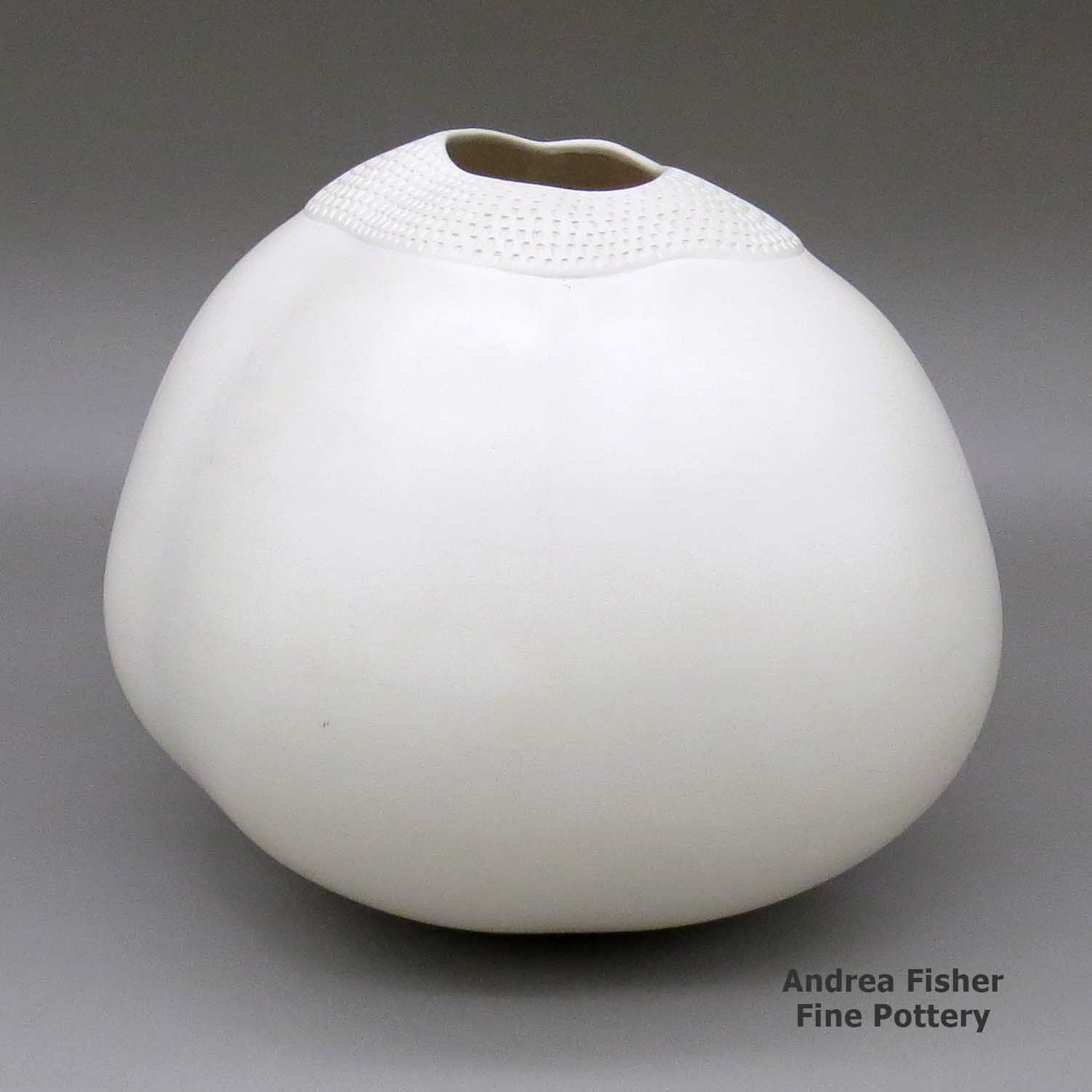
Winnebago
$ 2750
jwwn3m203
Large white jar with an organic form and a corrugated design around opening
11.5 in L by 11 in W by 9.5 in H
Condition: Very good, rubbing on bottom and marks on side
Signature: Jacquie Stevens, with date
Date Created: 1989
Tell me more! Buy this piece!
(505) 986-1234 - www.andreafisherpottery.com - All Rights Reserved
Jacquie Stevens
Winnebago
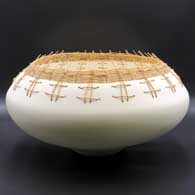
"Otellie taught me that each pot has its own life, personality, character and form - and that is what set me free."
Jacquie Stevens was born in Omaha, Nebraska in 1949. She was raised by her grandparents on the Winnebago Nebraska Reservation, about 75 miles north of Omaha. The Nebraska reservation had been formed in 1832 and thousands of Winnebagos from their ancestral homelands in Wisconsin were transported there between 1832 and 1874. The "removal" went on for so many years because many of the tribe just kept returning to Wisconsin. When the Homestead Act was passed by Congress in 1862, many Winnebagos went through that process to try to legally claim homesteads in Wisconsin. Different levels of government kept pushing back at them until Congress finally passed the Indian Homestead Act in 1875. That ended the forced removals and cleared a path for Winnebagos to legally return and stay. Today there is the larger, officially recognized Ho-Chunk Nation in Wisconsin and the smaller officially recognized Nebraska Winnebago Reservation. The two are recognized by Congress as separate tribal entities but they work together almost hand-in-hand.
Note: "Ho-chunk" translates as People of the Big Voice and their language is recognized as the parent language of more than 15 languages in the Siouan language family. "Winnebago" is the result of a misnomer from the Algonquian language family relating the tribe to the marshlands left by retreating glaciers at the end of the last Ice Age. There are many stories about how the Ho-Chunk came to inhabit the Wisconsin area but they all agree the Ho-Chunk were there hundreds of years ago. They are likely descendants of the prehistoric Woodland tribes as they grew their own corn and squash, celebrated similar annual ceremonies and developed similarly intricate beadwork and ceremonial costumes. However, the tribes around them remember the Ho-Chunk as coming from a region bordering salt-water somewhere. Those stories, though, are truly ancient and offer no indications as to whether that was Pacific salt water or Atlantic salt water (and it could well have been either). They were a powerful tribe that was decimated in historic times by an Act of Nature (hundreds of warriors drowned in a storm on Lake Michigan), by regular epidemics of European-introduced diseases, and by their own hatred of the Illinois Confederacy that bordered them to the south. When the Ho-Chunk really, really needed assistance to simply survive in the battle against their common enemy (the European invaders), the Illinois Confederacy came to help. They were almost immediately attacked by the remaining Ho-Chunk warriors. The Confederacy response to that almost wiped the Ho-Chunk off the map.
The reservation in Nebraska borders the Missouri River so there is clay in almost everyone's backyard. The kids all play with that clay, making little animals and unique objets d'art to play with. Much later in life Jacquie said that if she had known then what she knows now, she wouldn't have spent so many years doing other things that ultimately had less meaning for her. Like most female children growing up on the Winnebago Reservation, she was taught to do traditional Winnebago appliqué work on pillows, blanket shawls and ceremonial costumes. Many Ho-Chunk and Winnebago women excel at basket-making, too, but the making of pottery has never been a traditional Winnebago craft.
When she was 13 Jacquie was sent to an Indian boarding school in Flandreau, South Dakota. At 15 she was sent to the Haskell Institute (now the Haskell Indian Nations University) in Lawrence, Kansas. After graduating from there, she went to the University of Colorado at Boulder thinking to explore anthropology. In Boulder she was exposed to aboriginal art from around the world. She saw and felt the connections from around the globe with what she had been learning and doing as a child on the reservation. The emotion that stimulated in her caused her to enroll in the Institute of American Indian Arts in Santa Fe in 1975. She enrolled with her focus on the museum program they offered. Then she met Otellie Loloma, the Hopi woman in charge of the IAIA ceramics program at the time. During her first class with Otellie she said she felt "like I returned home; clay became my expression."
"Otellie taught me that each pot has its own life, personality, character and form - and that is what set me free. Pottery is like people, every one is different and not perfect. I thought about this and decided it was an important idea. So I developed a new way, an unconventional way, of looking at form." (from an interview with The Avant-Garde Magazine in 1996)
Jacquie earned her Associate of Fine Arts degree at IAIA, then earned her Bachelor of Fine Arts at the College of Santa Fe in 1981. In 1982 her work was featured in the "One with the Earth" exhibit at the Smithsonian Institute in Washington DC. One of her pieces earned a blue ribbon at the Heard Museum Indian Arts Fair & Market in 1982. Another piece earned another blue ribbon there in 1984. In 1983 she earned a blue ribbon at the Santa Fe Indian Market. SWAIA, the sponsors of Santa Fe Indian Market awarded her with a Fellowship that same year.
Jacquie earned many more awards over the years and was a featured participant in many exhibitions from coast-to-coast. Jacquie was one of the first Native American potters to coil large, intentionally off-round and free-form vessels. And while she scraped and sanded most to flawless surfaces, she wasn't into burnishing or glazing them. Most of her clay came from the Pecos, NM area, although her love of subtle color changes in her pieces led her to test and incorporate clays she found in other places, too.
Jacquie also liked to add other materials to her pieces: wicker, woven reeds, wood, stones, leather, beads and shells. She had a unique view of the contrasts between a pure, clean form versus the disturbances caused when other materials were added. Her experimentation also didn't stop with the pieces themselves. Many of her coloring effects were created in her firing process. She often experimented with the form of the fires she built, the various (air-flow) baffles she put in place around each piece and the placement of the materials (dung, manure, pine, mesquite, juniper, etc.) she used in making the fire itself.
After not producing any pottery for several years, Jacquie passed on in 2021.
Some Exhibits that Featured Works by Jacquie
- Images, Artists, Styles: Recent Acquisitions from the Heard Museum Collection. Heard Museum North. Scottsdale, Arizona. July 2001 - January 2002
- Eight Artists II. Southwest Museum. Pasadena, California. September 27, 1987 - January 5, 1988. Note: exhibiting artists includes Clifford Beck, Jody Folwell, Bob Haozous, Robert Houle, Richard Glazer-Danay, Felice Lucero-Giaccardo, Edna Davis Jackson and Jacquie Stevens
- Women of Sweetgrass, Cedar and Sage. Gallery of the American Indian Community House. New York, NY. June 1, 1985 - June 29, 1985
- 1984 Heard Museum Guild Native American Invitational Arts Show. Heard Museum. Phoenix, Arizona. November 16-30, 1984
Some Awards earned by Jacquie
- 2004 Santa Fe Indian Market, Classification II - Pottery, Division J - Non-traditional ceramics, all materials, all techniques with or without decorative elements, any form, any design: Best of Division
- 2004 Santa Fe Indian Market, Classification II - Pottery, Division J - Non-traditional ceramics, all materials, all techniques with or without decorative elements, any form, any design, Category 1604 - Jars, wedding jars and vases, painted and unpainted, other than stoneware: First Place
- 1984 Heard Museum Guild Native American Invitational Arts Show, Classification II - Pottery, Division B - Contemporary, wheel-thrown, glazed, kiln-fired: Second Place. Awarded for artwork: Tall Pot with leather sea urchin spines
Corrugated Pottery
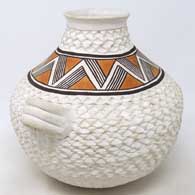
Jessie Garcia
Acoma
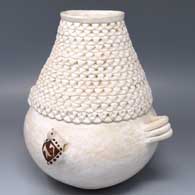
Stella Shutiva
Acoma

Jackie Shutiva
Acoma
Most corrugated pottery is made by coiling a pot but instead of using a piece of gourd (or something with a similar hard, sharp edge) to smooth the coils on the outside, like most other pots, a finger or tool is used to make regular indentations in the coils. Sometimes the coils are smoothed and a tool used to add corrugation to the smooth surface after. Corrugation often covers an entire piece but is also sometimes used in bands to decorate pots in a manner other than painting, carving or etching.
The corrugated pottery pattern was revived by Jessie Garcia after she came across corrugated potsherds lying on the ground near her home at Acoma. They were left over from the work of unknown potters hundreds of years ago.
A corrugated cooking jar offers more surface area to a fire: it heats up faster and the heat distribution is more even. As a design pattern she felt she could make uniquely her own, Jessie spent years perfecting it. Then she taught her daughter, Stella Shutiva, how to make it and Stella perfected it further. Stella even traveled to the Smithsonian Institute in Washington DC in 1973 to demonstrate how she made her corrugated wares. Then Stella taught her daughter, Jackie Shutiva, how to do it. Today, Jackie is the premier producer of corrugated pottery at Acoma, and she, too, has developed her own styles and forms.
Copyright © 1998-2024 by


